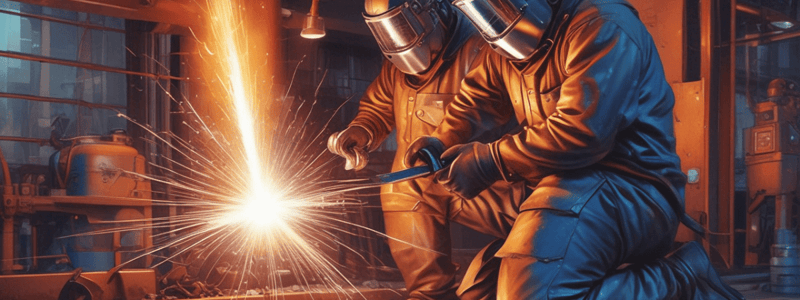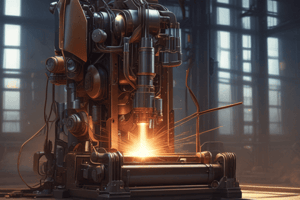Podcast
Questions and Answers
What is metal powder culling initially introduced for?
What is metal powder culling initially introduced for?
- Cutting cast iron
- Cutting stainless steel (correct)
- Cutting bronze
- Cutting alloy steels
What is a benefit of powder cutting in stack cutting?
What is a benefit of powder cutting in stack cutting?
- It can cut through separations (correct)
- It requires less oxygen
- It is faster than flame cutting
- It generates less smoke
What is the purpose of the chemical flux in flux cutting?
What is the purpose of the chemical flux in flux cutting?
- To reduce the heat generated
- To strengthen the cut metal
- To increase the oxygen flow
- To make the refractory oxides soluble (correct)
What type of steel is not recommended for cutting using chemical flux cutting?
What type of steel is not recommended for cutting using chemical flux cutting?
What is the recommended distance for positioning the flux-supply from the cutting area?
What is the recommended distance for positioning the flux-supply from the cutting area?
Why is chemical flux cutting slowly losing its industrial importance?
Why is chemical flux cutting slowly losing its industrial importance?
What is the purpose of moving the torch along the line of the cut?
What is the purpose of moving the torch along the line of the cut?
What type of material is not suitable for powder cutting?
What type of material is not suitable for powder cutting?
What is the purpose of heating the initiating point of cut to white heat?
What is the purpose of heating the initiating point of cut to white heat?
What happens if the hoses have sharp bends in chemical flux cutting?
What happens if the hoses have sharp bends in chemical flux cutting?
Flashcards are hidden until you start studying
Study Notes
Welding Definition and History
- Welding is the process of joining two metallic components with the application of heat, with or without the application of pressure and with or without the use of filler metal.
- Welding has been developing over a century, with the first recorded application of welding dating back to the "Bronze Age" where parts were joined by forge welding to produce tools, weapons, and ornaments.
- The first application of welding with carbon electrode was developed in 1885, while metal arc welding with bare electrode was patented in 1890.
Types of Welding Processes
- Fusion welding: where molten metal solidifies freely
- Pressure welding: where molten metal, if any, is retained in a confined space under pressure
- Arc welding: applies heat generated by an electric arc for melting the faying surfaces of the base metal
- Forge welding: a solid-state welding process in which both plates are heated quite below their melting temperature and then subjected to high pressure or hammering to create a weld joint
Classification of Welding Processes
- Based on the use of filler material
- Based on the source of energy
- Based on Arc and Non-arc welding
- Based on Fusion and Pressure welding (most widely used)
Applications of Welding
- Fabrication of pressure vessels
- Bridge construction
- Shipbuilding
- Aircraft and spacecraft construction
- Railway coaches and general applications
- Automobiles
- Electrical, electronic, and defense industries
- Nuclear installations
- Micro-joining
Submerged Arc Welding (SAW)
- Developed in 1935
- Uses a consumable electrode covered in a flux to protect the arc and molten metal
Gas Metal Arc Welding (GMAW)
- Developed in 1948
- Uses a continuous wire electrode and shielding gas to protect the arc
- Can be used for welding ferrous and nonferrous metals
- High deposition rate and versatility over a wide range of thicknesses and welding positions
Welding Symbols
- Used to communicate information about welding procedure without ambiguity
- Symbols are used to show the type of weld to be made, size and location of weld, welding process, edge preparation, bead geometry, and weld inspection process
Types of Weld Joints
- Butt joint: plates are in the same horizontal plane and aligned with a maximum deviation of 50
- Lap joint: plates overlap each other
- Corner joint: joint is made by melting corners of two plates
- Edge joint: joint is made by melting the edges of two plates
- T joint: one plate is approximately perpendicular to another plate
Types of Welds
- Groove weld: a weld that is made in a groove between two plates
- Fillet weld: a weld that is made on the corner of two plates
- Plug weld: a weld that is made by filling a hole in one plate with molten metal
- Bead on plate weld: a weld that is made on the surface of a single plate### Resistance Welding
- Resistance welding is a pressure welding process that uses heavy current to generate heat at the interface of two metals, without using fluxes or filler metals.
- The process is automatic, and all process variables are preset and maintained constant.
- Heat is generated by the expression H = I²Rt, where H is the heat generated, I is the current, R is the resistance of the area being welded, and t is the time for the flow of current.
- The process employs high currents (few kA), voltages (2-12V), and times (few ms to few seconds).
- Force is applied before, during, and after the flow of current to avoid arcing and to forge the weld metal during post-heating.
Spot Welding
- In spot welding, two or more sheets of metal are held between electrodes, and current is supplied for a definite time to generate heat.
- The principle is illustrated in Figure 11.2.
- The welding cycle involves the upper electrode moving and contacting the workpieces, applying pressure, and then passing heavy current for a preset time.
- The area of metals in contact is rapidly raised to welding temperature, and the pressure squeezes the hot metal together to complete the weld.
Seam Welding
- In seam welding, overlapping sheets are gripped between two wheels or roller disc electrodes, and current is passed to obtain a continuous or intermittent seam.
- The process of welding is illustrated in Figure 11.5.
- Types of seam welds include overlapping weld nuggets, which may vary from 10 to 50%.
- Seam welding is a fast method of welding, producing quality welds, but the equipment is costly and maintenance is expensive.
Projection Welding
- In projection welding, projections are little raised points that offer resistance during the passage of current, generating heat.
- The operation is performed on a press welding machine, and components are put between water-cooled copper platens under pressure.
- The projections can be generated by press working or machining on one part, or by putting an external member between two parts.
- No consumables are required in projection welding.
Production of Seam Welded Tubes
- Seam welded tubes are produced by resistance seam welding.
- The process involves wrapping a strip around a spool, forming the shape of the tube, and then seam welding the edges.
- The flash out is trimmed, and the tubes are cut to required size.
Thermit Welding
- Thermit welding is a chemical welding process that uses an exothermic chemical reaction to supply heat energy.
- The reaction involves the burning of Thermit, a mixture of fine aluminum powder and iron oxide, which reacts to form pure iron and slag.
- The process involves preparing the joint, pouring wax into the joint, creating a mould, and then pouring the Thermit mixture into the mould.
- The advantages of Thermit welding include its simplicity, speed, and low cost, but it is limited to welding heavy sections.
Plasma Arc Welding
- Plasma arc welding is an advanced version of TIG welding that uses a high-velocity plasma arc to melt the metal.
- The process is characterized by high energy density, low heat input, and reduced problems associated with the weld thermal cycle.
- The advantages of PAW include its ability to weld thin sheets, reduced angular distortion, and lower residual stress.
- The limitations of PAW include its complexity, high cost, and generation of high noise levels.
Oxy-Fuel Gas Cutting
- Oxy-fuel gas cutting is a thermal cutting process that uses a high-pressure oxygen jet to cut steel plates.
- The process involves preheating a small zone to the kindling temperature of the material, and then making the oxygen jet impinge on the hot metal.
- The reaction between the oxygen and metal generates heat, which is used to cut the metal.
- The width of the cut is referred to as the KERF, which is a function of oxygen hole size, flow rate, speed of cutting, and the nature of the material.### Powder Cutting
- Used for cutting cast iron, chromium-nickel, stainless steel, and some high alloy steels
- Working principle: injection of metal powder into the oxygen stream, which is heated by oxy-acetylene preheat flames, igniting and providing high temperature for cutting
- Powder is carried to the cutting torch by compressed air or nitrogen
- Cutting speeds and oxygen pressures are similar to those for cutting mild steel
- Flow rates: 0.10 to 0.25 kg of iron powder per minute of cutting
- Leaves a scale on the cut surface, which can be easily removed on cooling
- Can be used for cutting alloy steels, bronze, nickel, aluminum, steel mill ladle spills, certain refractories, and concrete
- Also used for gouging and scarfing, and stack cutting
Chemical Flux Cutting
- Involves injecting a chemical flux into the oxygen stream
- Flux combines with refractory oxides to form a soluble compound
- Chemical fluxes may be salts of sodium, such as sodium carbonate
- Flux is sucked from a hopper at the rate of 0.06 to 0.30 kg per minute
- Procedure: heating the initiating point of cut to white heat, opening the cutting oxygen valve, and leading the flux in oxygen stream to the torch
- Can be used for cutting cast iron, chromium-steel, chromium-nickel steel, copper, brass, and bronze
- Not recommended for cutting high-nickel type steels, such as 15 Cr 35Ni steel
- Losing industrial importance due to the development of more efficient methods like plasma cutting
Studying That Suits You
Use AI to generate personalized quizzes and flashcards to suit your learning preferences.





